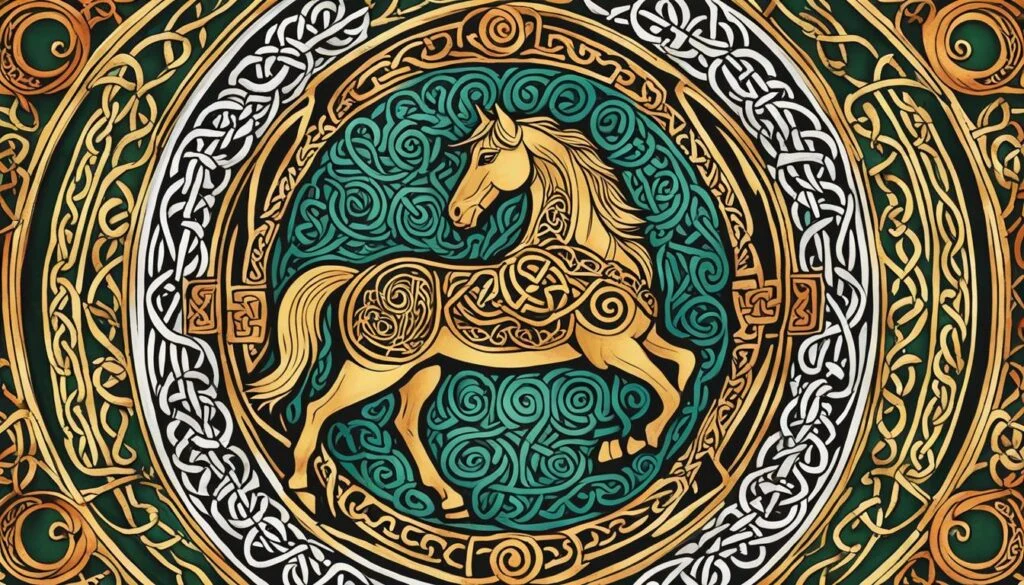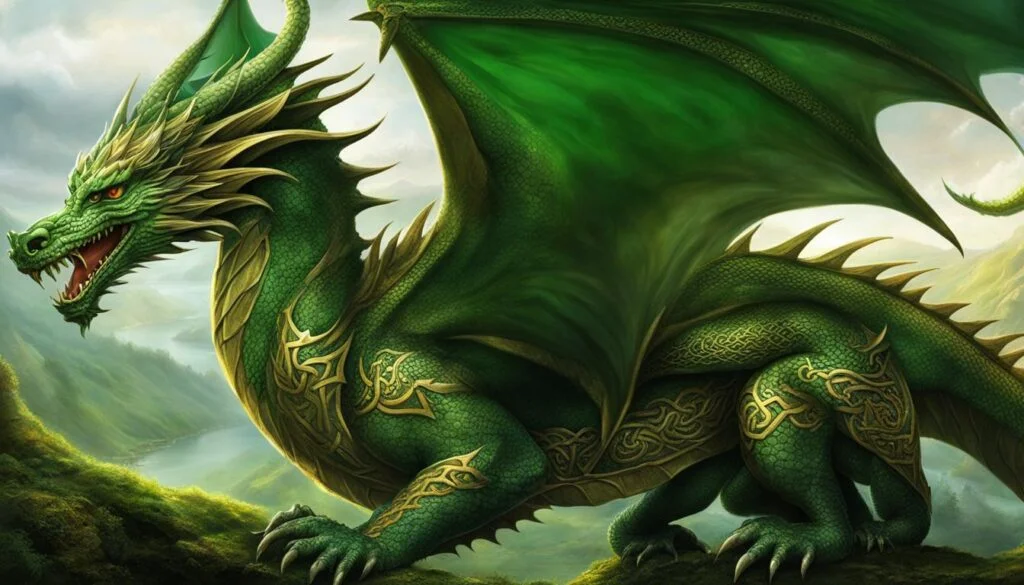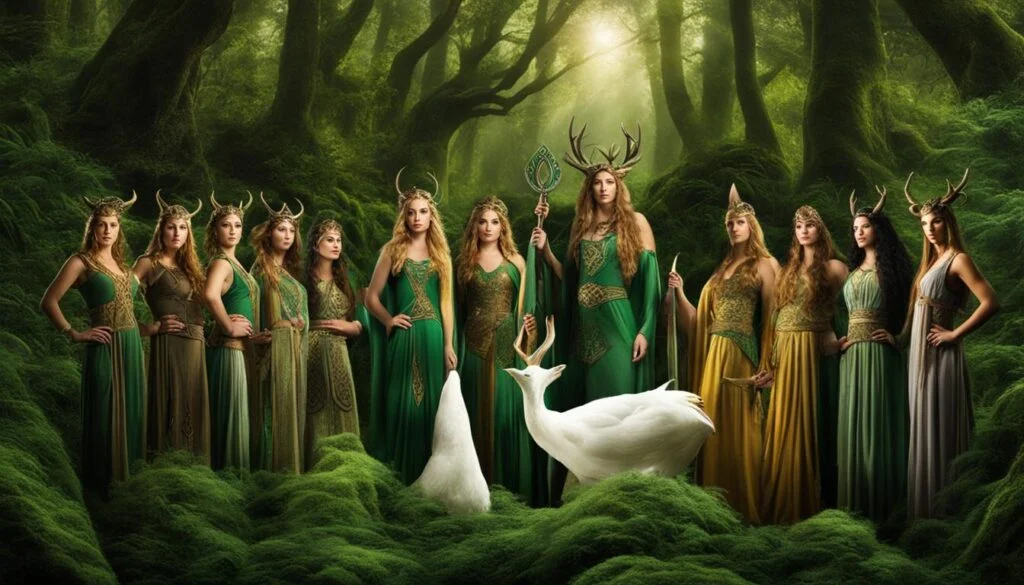Epona, the revered Celtic goddess, played a significant role in the ancient Celtic world. In Celtic mythology, she symbolized horses, fertility, and abundance, embodying the connection between mortals and the divine. Her worship was widespread throughout Gaulish culture and extended into the Roman Empire.
Epona’s name, derived from the Gaulish word for horse, reflects her association with these magnificent creatures. She was widely revered as a protector of horses and a patroness of cavalry. Her symbols, including patera, cornucopia, ears of grain, and depictions of horses, represented her multifaceted attributes.
Key Takeaways:
- Epona, a Celtic goddess, was worshipped for her association with horses, fertility, and abundance.
- Her worship spread throughout Gaulish culture and into the Roman Empire.
- Epona’s symbols included patera, cornucopia, ears of grain, and depictions of horses.
- Her cult was widespread, with inscriptions and artifacts found throughout Gaul and Germany.
- She was particularly revered as a protector of horses and a patroness of cavalry.
The Origins of Epona in Celtic Mythology
In Celtic mythology, Epona is revered as a horse goddess with a divine connection to horses. She is believed to have originated as a deity associated with fertility, abundance, and the otherworld. Epona is often depicted as a guardian and protector of horses, embodying the power and grace of these magnificent creatures.
One of the distinctive aspects of Epona’s mythology is her ability to shape-shift into different equine forms. This divine attribute represents the bridging of mortal and divine worlds, highlighting her extraordinary connection with horses.
Epona’s divine presence is often symbolized by various equine items such as horseshoes, bridles, and saddles. These symbols reflect her role as a champion of horses and emphasize her association with the equestrian realm.
Overall, Epona’s origins in Celtic mythology showcase her significant role as a horse goddess and her divine connection with horses, fertility, and the otherworld.
Feel free to click on the image above to get a visual representation of the Celtic goddess Epona.
Epona’s Role in Gaulish Culture
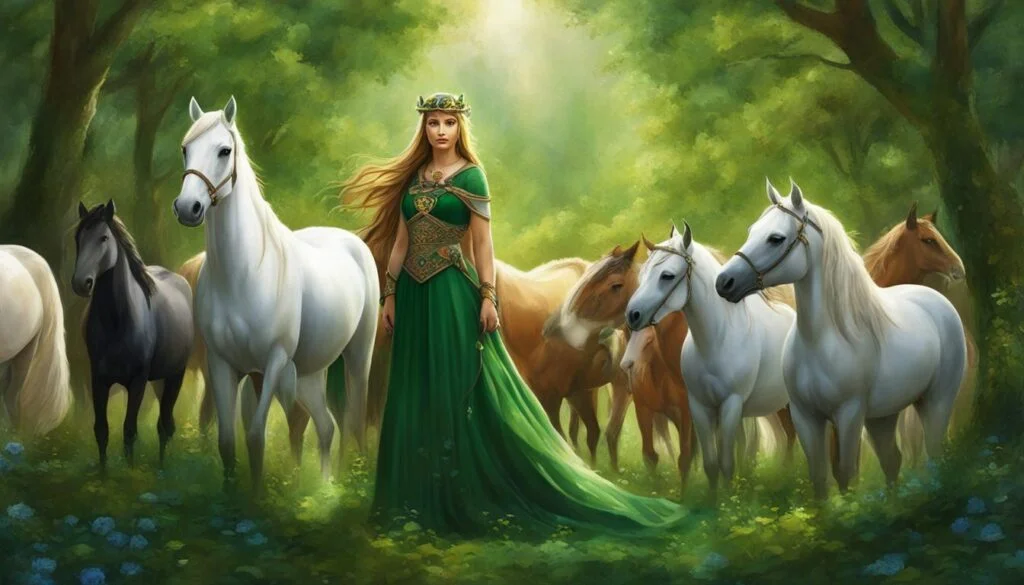
Among the Gaulish people, Epona held a significant place in their culture and daily life. She was widely revered as the patron goddess of horses and played a vital role in agriculture, transportation, and warfare. Epona’s association with fertility and abundance extended to the Gaulish people, who relied on the blessings of the land for survival.
Gallo-Roman artifacts found throughout Gaulish territories, such as statues, altars, and inscriptions, offer evidence of the Gaulish reverence for Epona and depict her adorned with equestrian attire. These artifacts not only showcase the deep connection between Epona and the Gaulish culture but also highlight her importance as a symbolic figure of prosperity and protection.
The depiction of Epona in Gallo-Roman art reflects her role as the guardian of horses and the provider of bountiful harvests. Her representation often showcases her in the presence of horses—whether seated on a mare or surrounded by them—signifying her divine connection with these magnificent creatures.
The Gaulish people celebrated Epona’s influence through various rituals, including offerings and processions, to express their gratitude and seek her benevolence. The worship of Epona in Gaulish culture permeated every aspect of their lives, from agriculture to warfare, symbolizing the integral connection between humans, land, and horses.
Role in Agriculture and Transportation
As the patron goddess of horses, Epona played a crucial role in agriculture and transportation for the Gaulish people. She was believed to bless the fields with fertility and ensure abundant harvests, signifying her importance in sustaining the agricultural livelihood of the community. Additionally, Epona’s connection to horses extended to transportation, where her presence was invoked to safeguard journeys and ensure the swift movement of goods and people.
Role in Warfare
Epona’s significance in Gaulish culture was also evident in the realm of warfare. As the patron goddess of horses and cavalry, she was called upon to protect warriors on the battlefield and grant them victory. The Gaulish people believed that Epona’s divine favor would ensure the courage, swiftness, and strength of their horse-mounted soldiers, making her an integral part of their military endeavors.
Through her association with horses and her role as the patron goddess of horses, fertility, and abundance, Epona became an essential figure in Gaulish culture. The Gaulish reverence for Epona was evident in the artifacts depicting her, which serve as a testament to her enduring legacy and the deep connection between the Gaulish people and their equine companions.
Epona’s Integration into the Roman Empire
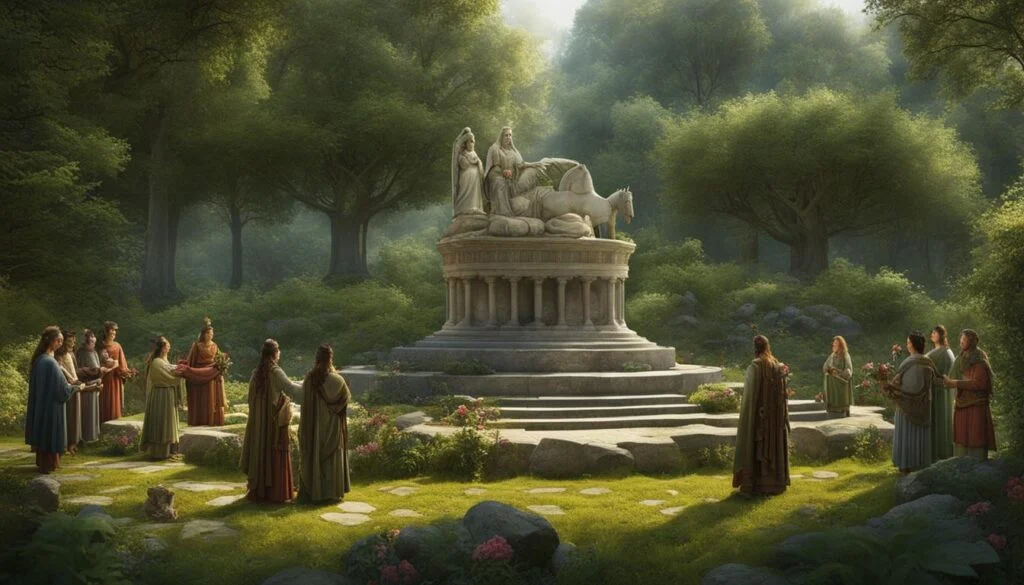
With the Roman conquest of Gaul, the worship of the Celtic goddess Epona underwent a significant transformation. Recognizing the cultural and religious importance of Epona to the Gaulish people, the Romans incorporated her into their own pantheon. This integration allowed Epona’s cult to flourish throughout the Roman Empire, spreading her influence and devotion to new regions.
Epona became syncretized with Roman deities, most notably the goddess Victoria. This merging of beliefs and practices facilitated the widespread veneration of Epona among diverse communities within the empire. Soldiers, traders, and civilians alike embraced Epona, transcending social boundaries and solidifying her status as a beloved and respected goddess.
The integration of Epona into the Roman Empire provided her worshippers with a sense of continuity and cultural unity. Her presence and influence extended far and wide, as indicated by inscriptions and artifacts found in various regions. The devotion to Epona prevailed even in the face of Roman rule, showcasing the enduring power of this Celtic goddess.
Symbolism and Attributes of Epona
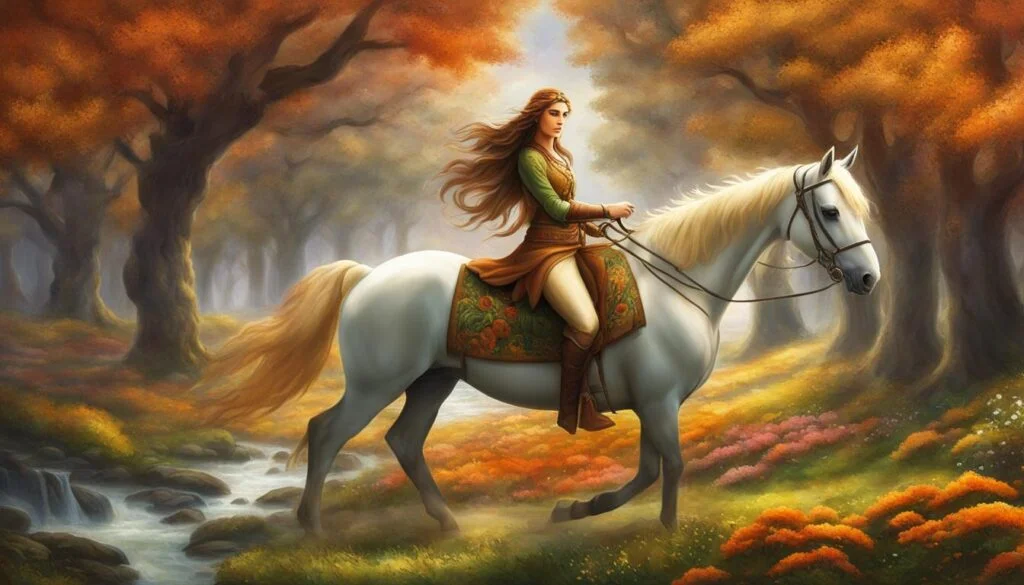
Epona, the Celtic goddess, embodies a multitude of symbolism and possesses distinctive attributes that reflect her role in ancient mythology. As the horse goddess, she symbolizes the power, grace, and beauty of horses. Epona is also associated with land and fertility, ensuring the prosperity and abundance of the earth. Her symbolism highlights the celestial nature of horses and their divine connection. Epona’s representation as the Horse Goddess emphasizes the bridging of mortal and divine realms and the interconnectedness of various deities.
Throughout Celtic mythology, Epona’s symbolism as the horse goddess reveals the reverence and divine connection with horses. Horses have long been admired for their strength, agility, and companionship with humans. Epona’s association with horses not only emphasizes their physical attributes but also signifies their spiritual significance and celestial nature. The graceful form and power of horses mirror the qualities of the divine world, and Epona embodies this connection.
Epona’s association with land and fertility further adds to her symbolism and importance in Celtic mythology. In ancient times, the prosperity and abundance of the land were crucial for the survival and well-being of the people. Epona’s role as a goddess of fertility ensured the bountiful harvests and the fecundity of the earth. She was worshipped to ensure the successful growth of crops, the well-being of livestock, and the overall prosperity of the community.
Epona’s symbolism as the Horse Goddess also speaks to the interconnectedness of various deities in Celtic mythology. Horses were considered sacred animals and were often associated with gods and goddesses representing different aspects of life. Epona’s representation emphasizes the harmonious relationship between these diverse deities, highlighting their shared influence and importance in the Celtic pantheon.
Worship and Rituals Associated with Epona
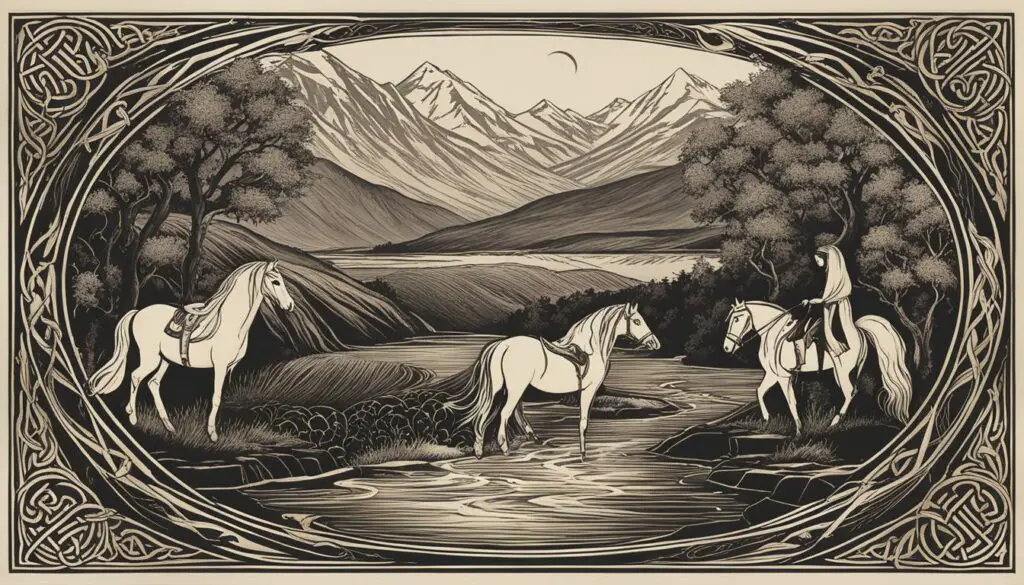
The worship of Epona in Celtic culture involved various rituals and practices to honor her presence and seek her blessings. Dedicated sanctuaries and temples were established for her followers to offer their devotion, prayers, and hymns. Offerings, ranging from simple tokens of respect to more elaborate gifts, were made to establish a reciprocal relationship with the goddess. Processions, ceremonial horse races, and the veneration of mares and foals were integral parts of Epona’s worship. These rituals aimed to connect with her power and seek her assistance in different aspects of life.
- Sacred Spaces: Epona’s worship was conducted in dedicated sacred spaces such as sanctuaries, temples, and groves. These locations provided a tangible connection to the divine and served as gathering places for devotees.
- Prayers and Hymns: Followers of Epona would offer prayers and recite hymns to express their devotion and seek blessings. These invocations were often accompanied by ritual gestures or actions.
- Offerings: Offerings were an essential part of Epona’s worship. They ranged from simple offerings of food, flowers, or incense to more elaborate gifts, including horse-related items and symbolically meaningful objects.
- Processions and Ceremonial Horse Races: Processions and ceremonial horse races were common in Epona’s worship. Participants would parade with horses adorned in her honor, and races would be held to celebrate her association with horsemanship.
- Veneration of Mares and Foals: Mares and foals held a special place in Epona’s worship. They were considered sacred animals, and their veneration was an act of devotion to the goddess.
Epona’s Role in Art and Literature
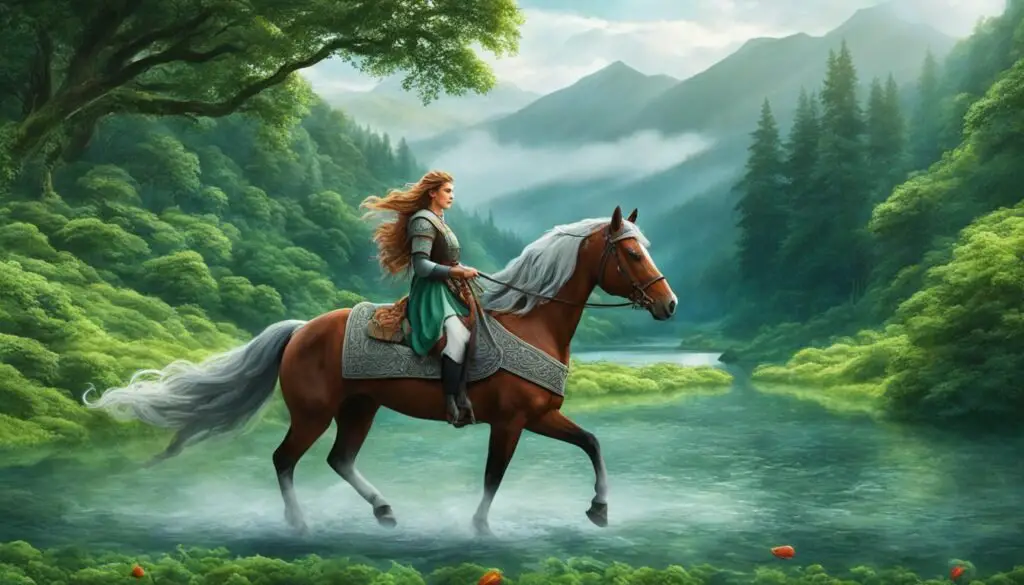
Epona’s influence transcends the realm of worship and rituals, leaving a lasting impact on art and literature. She is featured in several literary works, including The Golden Ass by Apuleius, where references to Epona highlight her significance in Celtic mythology. Moreover, Victor Hugo’s Les Misérables indirectly alludes to Epona through the character Éponine, showcasing her continued presence in storytelling and literature.
Within the realm of art, Epona is a popular subject, often depicted alongside horses. Whether portrayed seated on a mare or surrounded by majestic steeds, the representation of Epona varies based on the artistic style and origin. However, one consistent aspect is Epona’s connection and profound association with horses, which is magnificently conveyed through these artistic portrayals.
Epona’s influence extends into popular culture as well. Fans of The Legend of Zelda franchise will recognize Epona as the name of the beloved horse companion. This iconic representation of Epona in a widely acclaimed video game showcases the enduring power and inspiration of her mythological presence.
Epona’s captivating aura has even influenced musical creations, with artists drawing inspiration from her essence. Enya’s mesmerizing track titled “Epona” beautifully captures the spirit of this Celtic goddess, resonating with her mythical charm and enduring legacy.
Examples of Epona’s Representation:
- References in literary works such as The Golden Ass and Victor Hugo’s Les Misérables
- Depictions in visual art, often showcasing Epona alongside horses
- The presence of Epona as the horse companion in The Legend of Zelda franchise
- Inspiration drawn from Epona’s mythological essence in musical creations, including Enya’s track titled “Epona”
Epona in Celtic Mythology and Modern Worship
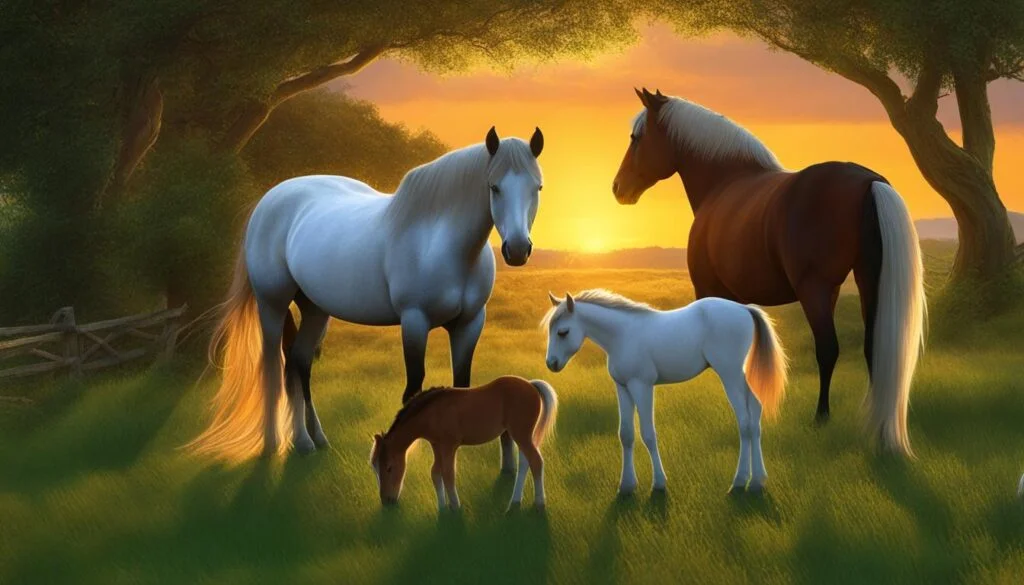
While exploring the realm of Celtic mythology, it becomes evident that Epona, the goddess associated with horses, holds a unique and prominent place. A captivating comparison can be made between Epona and another intriguing character, Rhiannon, both revered for their connection to horses and their role as companions to the dead.
Although Epona and Rhiannon share common traits, it is important not to overlook the subtle differences in their scope and cultural context. Each goddess possesses her own distinct attributes, contributing to the rich tapestry of Celtic mythology.
Epona’s worship extends beyond ancient times, resonating with modern practitioners of Paganism and Neopaganism. Neo-druids and followers of polytheistic beliefs continue to revere this Celtic deity, recognizing her as an enduring symbol of their spiritual devotion. Her association with horses and fertility make her a beloved figure in contemporary spiritual practices.
Epona’s enduring legacy is a testament to her significance in Celtic mythology and her ability to transcend the boundaries of time. As practitioners embrace her in modern worship, Epona’s presence continues to inspire and empower individuals on their spiritual journeys.
Conclusion
Epona, the Celtic goddess associated with horses, fertility, and abundance, held a significant role in the Celtic world and became integrated into the Roman Empire. Her symbolism and attributes, including her title as the Horse Goddess and her connection to land and fertility, emphasized her importance in Celtic mythology and culture. The worship of Epona involved various rituals, offerings, and acts of devotion. Her cult spread throughout Gaulish territories and beyond, leaving a lasting legacy.
Today, Epona’s enduring legacy can be observed in modern Paganism and Neopaganism. She continues to be revered as a significant deity, with followers honoring her through worship and rituals. Epona’s integration into the Roman Empire allowed her influence to expand, capturing the devotion of diverse communities within the empire, including soldiers, traders, and civilians.
Epona’s representation as the Horse Goddess symbolizes the power, grace, and beauty of horses, as well as their celestial connection to the divine realm. Her enduring legacy as a Celtic goddess, her role in ancient rituals, and her integration into Roman society have cemented her place in history and contemporary spiritual practices.
FAQ
How was the goddess Epona worshipped in the Celtic world?
The goddess Epona was worshipped in the Celtic world through rituals, offerings, and devotion. Dedicated sanctuaries and temples were established for her followers to offer their prayers and hymns. Processions, ceremonial horse races, and the veneration of mares and foals were integral parts of her worship.
What was Epona’s role in Gaulish culture?
In Gaulish culture, Epona held a significant place as the patron goddess of horses and a protector of the animal kingdom. She played a vital role in agriculture, transportation, and warfare. Epona’s association with fertility and abundance extended to the Gaulish people, who relied on the blessings of the land for survival.
How was Epona integrated into the Roman Empire?
With the Roman conquest of Gaul, the worship of Epona experienced a transformation. The Romans recognized her cultural and religious importance and incorporated her into their own pantheon. Epona became syncretized with Roman deities, particularly the goddess Victoria, allowing her worship to spread throughout the Roman Empire.
What are the symbolism and attributes of Epona?
Epona is symbolized as the Horse Goddess, representing the power, grace, and beauty of horses. She is also associated with land and fertility, ensuring the prosperity and abundance of the earth. Epona’s representation highlights the celestial nature of horses and their connection to the divine world.
What were the rituals and practices associated with Epona’s worship?
Epona’s worship involved various rituals, such as offerings and devotion. Her followers would make offerings, ranging from simple tokens of respect to more elaborate gifts, to establish a reciprocal relationship with the goddess. Processions, ceremonial horse races, and the veneration of mares and foals were also important aspects of her worship.
How is Epona represented in art and literature?
Epona is often depicted alongside horses in art, either seated on a mare or surrounded by them. She is mentioned in literary works such as The Golden Ass by Apuleius and indirectly referenced in Victor Hugo’s Les Misérables through the character Éponine. The horse in The Legend of Zelda franchise is named after her.
How does Epona’s role in Celtic mythology relate to modern worship?
Epona’s enduring legacy can be seen in modern Paganism and Neopaganism, where she is revered as a significant deity. She continues to be worshipped by neo-druids and other followers of polytheistic beliefs. Her association with horses and fertility makes her a significant figure in contemporary spiritual practices.
What is Epona’s significance in Celtic mythology?
Epona, the Celtic goddess associated with horses, fertility, and abundance, was widely worshipped and revered in the Celtic world. Her symbolism and role as the Horse Goddess emphasized the bridging of mortal and divine realms and the interconnectedness of various deities. Her worship played a vital role in Celtic culture and continues to be honored today.


